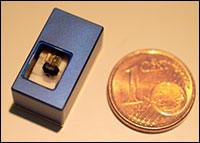
Sugar-Cube-Sized Video Projector Created
JENA & DRESDEN, Germany, Sept. 15, 2006 -- Researchers have overcome traditional obstacles and created a video projector no larger than a sugar cube. Instead of the conventional microarrays, it contains just a single mirror which can be rotated around two axes, making it smaller, lighter and handier than traditional projectors.
This projector created by German researchers gets by with a single mirror instead of a million. As a result, it is smaller and more manageable. (Photo: Fraunhofer IOF)
Cameras, MP3 players and memory chips are growing smaller by the day, and the next challenge for researchers was to shrink the projector, a device used day in day out in lecture halls and for video presentations. However, all attempts at miniaturization to date have come up against certain physical boundaries: the core piece of the classic projector is a micromirror array comprising a million mirrors. These can be tilted in one plane and are evenly illuminated. By turning toward or away from the light source, they produce light or dark pixels that together form the projected image. But not only do the arrays preclude miniaturization, their unaffordable prices also make it difficult for projectors to enter the consumer goods market.
Researchers at the Fraunhofer Institute for Photonic Microsystems IPMS in Dresden and the Fraunhofer Institute for Applied Optics and Precision Engineering IOF in Jena have devised an alternative to the previous micromirror arrays, and the result is a projector the size of a sugar cube.
“We use just one single mirror,” reveals Andreas Bräuer, director of the Microoptic Systems Div. at IOF. “This mirror can be tilted around two axes.”
The next obstacle in the miniaturization process is the light source. The customary high-pressure lamp will have to give way to small diode lasers if the projector is to shrink to sugar cube size. While red and blue diode lasers are already small enough, green lasers are still too bulky. Today’s technology allows RGB (red, green, blue) projectors with a side length of 10 x 7 x 3 cm to be produced. Although this is still distinctly larger than a sugar cube, it is only a quarter the size of a standard projector.
Researchers around the globe are attempting to scale down the green light source. Together with the blue and red diode lasers, it will ideally form the new red-green-blue source. “If green diode lasers are successfully reduced to the size of red ones, then RGB projectors the size of sugar cubes will become a reality,” said Bräuer.
Such a device would prove useful in many areas. The automotive industry, for example, requires small, cost-effective laser arrays to act as distance sensors that measure the gap between the car and the nearest object when parking. Sensors of this type are also used in robotics and installation technology. Yet another application for the minilasers is in digital projectors, which can be integrated in mobile devices such as laptops or PDAs.
For more information, visit: www.fraunhofer.de
Published: September 2006